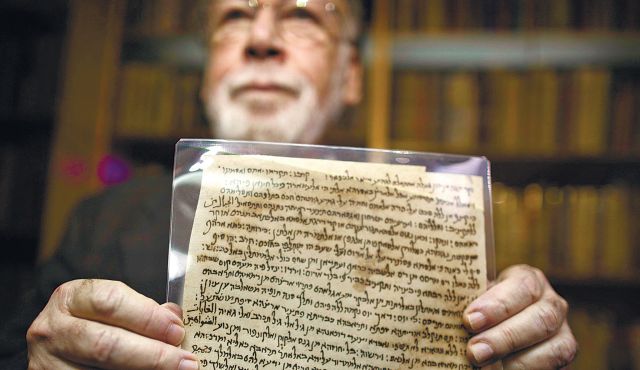The documents were reportedly discovered by villagers in a cave in eastern Afghanistan, near Iranian and Uzbeki border. Collection of 29 pages include writings by Saadia Gaon.

Professor Haggai Ben-Shammai displaying one of the Afghan Genizah documents. Photo by AFP
The National Library of Israel recently purchased 29 pages that are part of a cache of Jewish documents from Afghanistan. The collection includes unknown writings by Saadia Gaon as well as legal and family correspondence from 1,000 years ago. The cache, sometimes known as the Afghan Genizah, has rocked the world of scholars who study ancient manuscripts, and the dealers who buy and sell them, to name just two groups. The find has been compared to the 19th-century discovery of the Cairo Genizah in significance.
Information about the documents, which originated in the Jewish communities of Central Asia during the Middle Ages, is wrapped in layers of legend and rumor. They were reportedly discovered by villagers in a cave in eastern Afghanistan, near the Iranian and Uzbeki borders. Rumor has it that the cave was home to a family of foxes. In recent years the caves have served as hideouts for Taliban insurgents in Afghanistan.
No one knows the exact number of manuscripts in the Afghan Genizah but it is thought to be in the low hundreds, minuscule in comparison to the 200,000 or so of the Cairo cache, and spread among a number of dealers in Switzerland, England and other countries. One Jerusalem antiquities dealer who obtained a small part of the collection offered it for sale to the National Library. The negotiations continued for more than a year.
The library refused to say how much it paid for the collection, adding that it hoped to purchase more in the future and didn’t want to drive up prices. The documents arrived in Israel last week.
“The area where the material was found, which today is considered remote, was an important cultural, political and economic center in the Medieval era,” said Prof. Haggai Ben-Shammai of Hebrew University, who is the library’s academic director. Research links the growth of the Jewish communities in the region to the Silk Road, the main trading route between China and Europe during the Middle Ages. “Along the way, Jewish trading stations were established for Jewish traders, and over time they became Jewish communities. There is documentary evidence of Jews from Baghdad and Aleppo, of Karaite Jews and Jews from Persia, all of whom settled in the same region,” Ben-Shammai explained. Scholars at the library hope the ancient pages will shed light on these Jews.
“We’ve had many historical sources on Jewish settlements in that area,” Ben-Shammai said. “This is the first time that we have a large collection of manuscripts that represents the culture of the Jews who lived there. Until today we had nothing about this.”
The manuscripts include religious writings but also letters and civil contracts. They were written in Hebrew, Aramaic, Arabic and Persian, and in a variety of alphabets. Some are in Judeo-Arabic or Judeo-Persian (Arabic or Persian, respectively, written in Hebrew characters). Some of the Hebrew-language correspondence use the Babylonian system of vowelization, or nikud, in which the vowelization marks are all above the characters, which was common among Baghdadi Jews.
The most important manuscript in the group acquired by the library is a page from Saadia Gaon’s commentary on the Bible, written in the 10th century. Written in Judeo-Arabic, it is a commentary on Isaiah 34. It appears to have come from a transcription of a work of Gaon’s that was split up among various communities, and no other extant copies of this page are known to exist.
The pages are undergoing a process of conservation and preservation, before being scanned and uploaded to the National Library’s website. A small sample was removed from one of the documents that has been attributed to Saadia Gaon and sent to the Weizmann Institute of Science for carbon dating. “You have to study for years in order to successfully forge just a few lines of Judeo-Persian,” Ben-Shammai said.
Click here for article.
